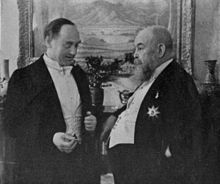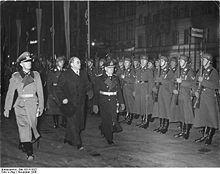- Oswald Pirow
-
Oswald Pirow K.C. 
Oswald Pirow (left) with Dr Hendrik Muller South African Minister for Justice In office
1929–1933Prime Minister J. B. M. Hertzog Preceded by Tielman Roos Succeeded by Jan Smuts Minister of Defence (South Africa) In office
1933–1939Preceded by Frederic Creswell Succeeded by Jan Smuts Personal details Born 14 August 1890
Aberdeen, Eastern CapeDied 11 October 1959 (aged 69)
PretoriaNationality South African Political party National Party Spouse(s) Else Piel Children 2 sons, 2 daughters Residence Valhalla Farm, near Pilgrim's Rest Profession Lawyer Oswald Pirow (Aberdeen, Eastern Cape, South Africa, August 14, 1890 — Pretoria, October 11, 1959) was a South African lawyer and far right politician, who held office as minister of Justice and Defence.
Contents
Early life
The son of German immigrants, he was educated at Potchefstroom, Transvaal, before continuing his education in Germany and England. He was called to the bar by the Inner Temple in 1913, then practised law in Pretoria, becoming a King's Counsel in 1925. He married Else Piel in 1919, the marriage producing two sons and two daughters.[1] During this time Pirow was a keen sportsman and was a champion at the javelin throw, whilst also excelling at boxing, wrestling, fencing, sprinting, swimming, horsemanship and big game hunting.[2]
Move into politics
Pirow came under the influence of Tielman Roos, an important figure in Transvaal and became a member of James Barry Munnik Hertzog's National Party being elected to parliament for Zoutpansberg in 1924. He was eliminated in 1929 however after running against Jan Smuts in Standerton.[1] However, despite this he was appointed to the Cabinet as Minister of Justice in place of Roos, who stood down, initially as a nominated senator. He won a by-election in October 1929 in Gezina however to confirm things and continued to represent the seat until 1943.[1]
Pirow advocated the merger of the National Party to the South African Party and became a leading member of their new government, forming Hertzog's 'inner cabinet' alongside Smuts and N.C. Havenga.[1] Aviation had been an early hobby of Pirow's and thus was to influence his work as a cabinet minister.[2] His role in the cabinet also included responsibility for railways and harbours and from this basis he founded South African Airways and furnished it with Junkers aircraft.[1] For Pirow, a strong advocate of both republicanism and a greatly increased role for South Africa in Africa as a whole, the foundation of the national airline was an important step in making the country more powerful.[3]
Nazism
 November 1938: Pirow being sent off in Berlin with soldiers from the Luftwaffe, to his left Wilhelm Canaris, to his right Ernst Seifert, photo from the German Federal Archives
November 1938: Pirow being sent off in Berlin with soldiers from the Luftwaffe, to his left Wilhelm Canaris, to his right Ernst Seifert, photo from the German Federal Archives
A vehement anti-communist (indeed, when running in Gezina in 1929 Pirow vowed to legislate communism out of existence[4]), Pirow became an admirer of Adolf Hitler after meeting him in 1933. He toured Europe in 1938 and claimed to offer Hitler a free role in Eastern Europe in return for allowing the Jews to leave Germany. During this tour he also met Benito Mussolini, António de Oliveira Salazar and Francisco Franco and became convinced that a European war was imminent, with Nazi victory assured.[1] Pirow's Germanophilia was such that the family spoke only German at home and his daughter Else even caused a minor controversy in Britain in June 1939 when she told the Daily Express that the Pirows felt more German than South African.[5]
Pirow supported Hertzog's calls for neutrality when war did arrive and followed his leader in to the new Herenigde Nasionale Party (HNP).[1] By September 1940 he had launched his own New Order group within the HNP, backing a Nazi style dictatorship.[1] This group took its name from his 1940 New Order in South Africa pamphlet in which he embraced the ideology. The pamphlet ran through seven editions in its first year of existence.[6]
Daniel François Malan initially tolerated the actions of the New Order but soon came to see it as a divisive influence on the HNP and at the Transvaal party congress of August 1941 he forced through a motion ending the group's propaganda activities, particularly their insistence on a one-party state.[7] Pirow and 17 of his supporters in Parliament reconstituted as the New Order on 16 August, although they continued to be associated with the HNP and attend their caucus meetings.[7] The group finally broke from the HNP altogether in 1942 after both Malan and Johannes Gerhardus Strijdom openly rejected the Nazis.[1] Pirow did not run in the 1943 election although a number of New Order candidates did and they were all heavily defeated. Although Pirow continued to publish a newsletter until 1958 his political career was effectively over, leaving him to return to legal practice.
Final years
Pirow was counsel for the defence of Dr Ernst Jokl[8] and others when they were sued in the F. M. Alexander libel case in South Africa in 1944-1948, which Alexander won.[9]
Having been removed from the political scene, largely by Malan's influence, Pirow became a friend of Oswald Mosley and with him developed an idea for the division of Africa into exclusively black and white areas.[2] The two met after Pirow read a copy of Mosley's book The Alternative and by 1947 they were in discussion over founding an anti-communist group to be known as the "enemies of the Soviet Union" (although this plan never reached fruition).[10] The two co-operated during the early 1950s, with Pirow writing articles for the Union Movement journals Union and The European, some of which were reprinted in German magazine Nation Europa.[11] By 1953 however Pirow had lost interest in Mosley due to his lack of real influence and instead began to co-operate with A. F. X. Baron's NATINFORM, which was largely hostile towards Mosley.[11]
Pirow acted as a prosecutor for a time during the Treason Trial of 1956. Despite his Nazi past some admiration for him grew amongst the African National Congress defendants, with Nelson Mandela being said to have 'developed a certain affection' for him, largely due to his politeness in referring to the accused as 'Africans'.[12]
Following the trial Pirow largely lived in retirement, publishing several books on wildlife and adventure books for boys.[2] He died of heart failure. He was cremated and his ashes are kept at his Valhalla Farm residence near Pilgrim's Rest.[1]
Preceded by
Frederic CreswellMinister of Defence (South Africa)
1933–1939Succeeded by
Jan SmutsReferences
- ^ a b c d e f g h i j N.G. Garson, 'Oswald Pirow' entry in Oxford Dictionary of National Biography
- ^ a b c d Philip Rees, Biographical Dictionary of the Extreme Right Since 1890, p. 297
- ^ R.L. McCormack , 'Man with a Mission: Oswald Pirow and South African Airways, 1933-1939', The Journal of African History, Vol. 20, No. 4, White Presence and Power in Africa. (1979), pp. 543-557.
- ^ 'White Terror'
- ^ Brian Bunting, The Rise of the South African Reich, Penguin Books, 1969, p. 57
- ^ 'Armed Struggle'
- ^ a b Bunting, The Rise of the South African Reich, p. 111
- ^ Dr Ernst Jokl (1907-1997) was in 1942 the South African Government's newly appointed Director of Physical Education
- ^ Bloch, Michael, F.M. The Life of Frederick Matthias Alexander, Little, Brown (London, 2004) Chapter 7,
- ^ G. Macklin, Very Deeply Dyed in Black - Sir Oswald Mosley and the Resurrection of British Fascism after 1945, New York: IB Tauris, 2007, p. 84
- ^ a b Macklin, op cit, p. 85
- ^ T. Lodge, Mandela: A Critical Life, p. 64
pre-Apartheid (1910-1948) Apartheid-era (1948-1994) Post-Apartheid (1994-present) Pre-Apartheid (1910-1948) Apartheid-era (1948-1994) Post-Apartheid (1994-present) Categories:- 1890 births
- 1959 deaths
- People from the Eastern Cape
- Cardiovascular disease deaths in South Africa
- Deaths from heart failure
- Afrikaner people
- White South African people
- South African lawyers
- South African Nazi collaborators
- South African Nazis
- South African people of German descent
- Defence ministers of South Africa
- National Party (South Africa) politicians
- Government ministers of South Africa
Wikimedia Foundation. 2010.
